Hurricane Camille anniversary: Mississippi man recalls surviving night of peril during Category 5 storm
Hurricane Camille ranks among the most intense hurricanes to ever strike the U.S. Then-Mississippi resident Don Larson lived through the disaster and wrote a memoir about his experience.
FOX Weather Flashback: Hurricane Camille devastates Gulf Coast
Hurricane Camille, a Category 5 storm, made landfall in Mississippi with 175 mph winds, 24 feet of storm surge. (Video from August 2022)
GULFPORT, Miss. - If you've ever lived through a hurricane, then you'll never forget the roar of the ferocious winds, the intense rainfall or the relentless waves from an angry ocean crashing ashore.
This is especially true if you're fighting to survive while the world around you is being destroyed.
That is what happened 55 years ago on Aug. 17, 1969, when catastrophic Hurricane Camille pounded the Gulf Coast as a Category 5 hurricane with winds estimated at about 175 mph along with a deadly storm surge of about 24 feet.
Hurricane Camille ranks among the most intense hurricanes to ever strike the U.S.
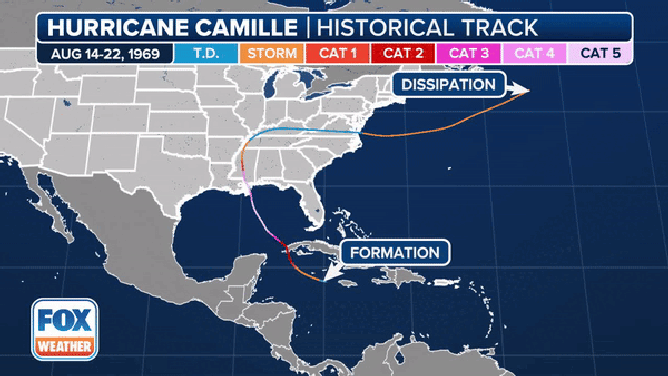
This animated image shows the path of Hurricane Camille in August 1969.
(FOX Weather)
Seattle resident Don Larson grew up in Mississippi and lived through the disaster. He used his memories of the terrifying ordeal to write a memoir called "Camille: One Family’s Story" to ensure memories of the disaster live on.
"There are books about Hurricane Camille, but none of them are from the point of view of an individual or a family," Larson told FOX Weather. "Anybody who lived through that, or any other disaster, has their own story."
He said he hopes his story will provide context as to what he and his family experienced.
"I knew in writing (the memoir) that I wanted to do something a larger audience, not just our family, could identify with," Larson said. "Putting themselves in this position or imagining themselves in this situation. Or their own story of survival."
This is his story of survival.
HOW TO PREPARE FOR HURRICANE SEASON
Family determined to ‘ride it out’ in Gulfport home
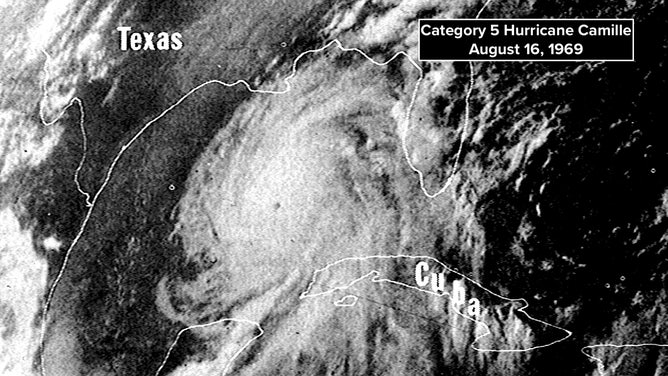
Satellite image of Hurricane Camille on Aug. 16, 1969.
(NOAA)
In August 1969, Larson was working as a lifeguard at his local pool in Vicksburg, Mississippi.
He recalled that it was a typical summer day in the South – hot and humid.
"We were listening to the radio by the pool," he said. "It was the last day the pool was going to be open for the season."
In Gulfport, about 200 miles to the southeast of Vicksburg, Larson's grandparents were aware of Camille looming in the Gulf of Mexico.
Radio broadcasters were urging people to prepare for the hurricane, which was rapidly intensifying as it approached the northern Gulf Coast.
WHAT’S THE DIFFERENCE BETWEEN A TROPICAL DEPRESSION VS. TROPICAL STORM VS. HURRICANE?
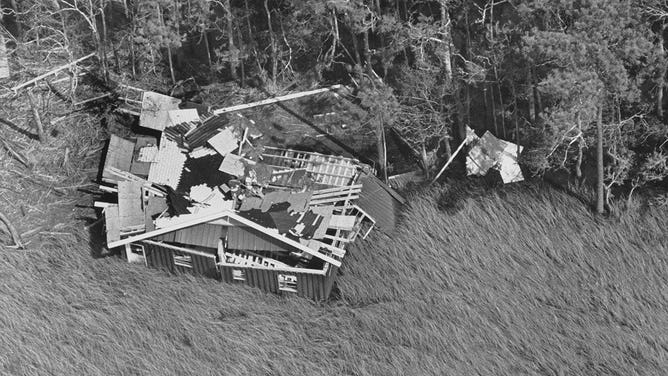
Seemingly adrift in a sea of grass, this house lies in a jumble, far from the foundation it rested on before the devastating winds and rain of Hurricane Camille.
(Getty Images)
"Well, that was the last time we talked to my grandparents, because it was the day before Camille," Larson recalled. "The evening of that same day that I was at the city pool, we talked to them on the phone, and they said they were going to ride it out."
Larson said that despite pleas from his mother to pack up the car and make the 3.5-hour drive to Vicksburg, they were determined to stay.
"They decided to stay there because they had been through several hurricanes over the years, although this one was forecast to be much worse," he said.
Hurricane Camille was just hours away from landfall, and Larson’s family was about to receive devastating news.
"It was during that night that my grandfather passed away of natural causes," he said.
WHAT IS THE GULF OF MEXICO 'DEAD ZONE'?
Racing into the danger zone ahead of Hurricane Camille’s landfall
After receiving word of his grandfather’s death, Larson said he and his parents got into the car and made the somber drive to Gulfport.
"On the morning of Camille, Sunday morning the 17th, a lot of people started to evacuate who had not evacuated prior," he said. "So it was pretty obvious that it was going to be an exceptionally severe hurricane."
Larson said that he believes it was estimated at the time that about 200,000 people were fleeing the coast for safety, and everyone was packing roads and highways to get as far inland as possible.
"It was a significant portion of the population in a three-county area at the time," he said.
In his memoir, Larson said he remembers seeing all the cars on the highway as he and his family approached Gulfport.
"When we drove east from Vicksburg to Jackson, the traffic was fairly light," Lason remembered. "Although there was more traffic coming westbound, which means they had been coming northbound via U.S. 49. And as we turned from Jackson toward the coast, that’s when we encountered the first of the heavy traffic going in the opposite direction."
Larson said that as they approached the coast, the traffic got heavier and then lighter. Many people had already been able to leave the area.
WHAT IS MY HURRICANE EVACUATION ZONE?
‘What are the names of your next of kin?’
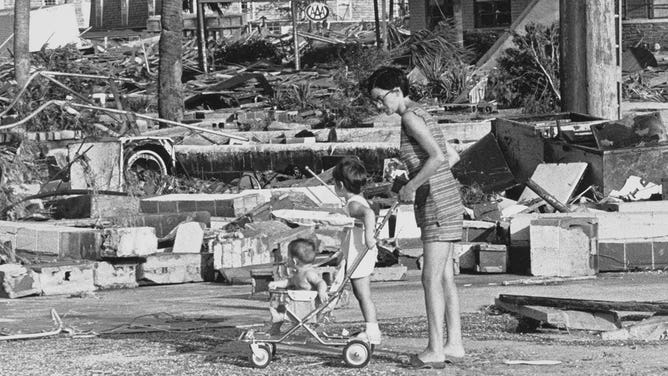
A woman walks her children through the Camille's destruction in Biloxi.
(Getty Images)
Shortly after arriving at his grandparent’s home, conditions began to deteriorate.
The family huddled inside the home as the rain and wind began to pick up in intensity, and that’s when Larson said there was a knock at the door.
It was a Civil Defense officer who was going door-to-door telling people who hadn’t left to go and seek shelter elsewhere.
The family was determined to stay. In his memoir, Larson wrote that he remembered the officer asking, "What are the names of your next of kin?"
"I think (the question) had a dual purpose," Larson said. "One was to get the attention of the people being contacted that weren’t evacuating."
But Larson said it was also a valid question to be asked.
"It was a legitimate task for the Civil Defense to find out who was staying behind, and who would need to be notified if they didn’t survive."
WHAT TO DO WHEN A HURRICANE WATCH OR TROPICAL STORM WATCH AND WARNINGS ARE ISSUED FOR YOUR TOWN
A deafening roar and unsettling sounds
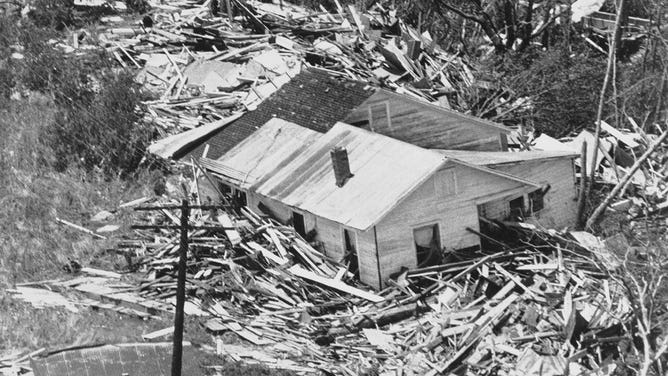
This is just one of a row of homes in the resort community of Pass Christian, MS, still recognizable as such after being ravaged by Hurricane Camille.
(Getty Images)
In Larson’s memoir, he recalls hearing high-pitched sounds and a deafening roar from the hurricane’s ferocious winds blasting against the home.
The water was rising fast, and there were no signs that the storm was letting up anytime soon.
"I was only 16 at the time," he said. "I was, on one hand, somewhat scared, but also fascinated by what was happening."
Larson said he went from door to door inside the home, looking out windows to witness Camille’s fury.
And as the storm raged, that’s when Larson and his family felt the home begin to shift.
7 FACTS TO KNOW ABOUT HURRICANES

The aftermath of Hurricane Camille ca. 17 August 1969.
(Getty Images)
The deadly storm surge that was pushing water inland actually picked up the home, and it began to float.
"When I first became, I guess, frightened in a major way, was when the house started floating," Larson said. "We couldn’t see outside. We knew it was the storm surge from the Gulf that was lifting the house up."
Larson said he and his family didn’t know if the house would be carried out into the open waters of the Gulf – a scenario that could have very well played out if it wasn’t for obstacles in the way.
WHY SOME POWER COMPANIES SHUT OFF ELECTRICITY AHEAD OF A HURRICANE
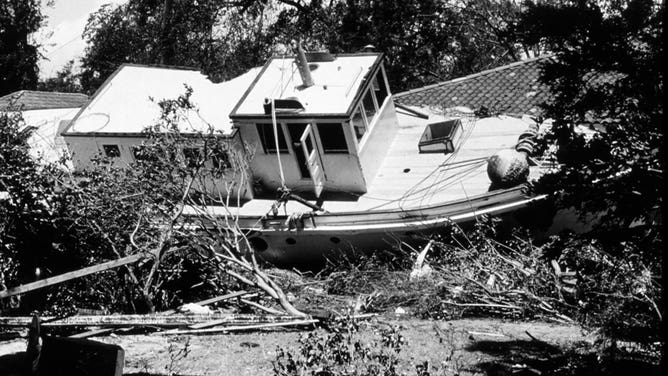
Fishing vessel driven ashore by Hurricane Camille - Biloxi Mississippi ca. 1969.
(Getty Images)
"It could have been if it was in some other area that didn’t have houses destroyed or debris piled up," Larson said. "It was like a breakwater behind the house. That’s what saved us."
Larson said his family had no way of knowing where the home was going, but all the debris in the water prevented the home from drifting too far.
"There were three rows," he said. "Three rows of houses between our house and the beach. And three rows of houses were obliterated and ours was the first one that wasn’t."
HOW EXTREMELY WARM GULF OF MEXICO WATERS CAN LEAD TO MONSTROUS STORMS
Quiet after the storm

FILE - Members of the Georgia National Guard unload food donated by the US Department of Agriculture for distribution to those affected by Hurricane Camille, Biloxi, Mississippi, August 1969. More than 2 million pounds of food has been made available to relief agencies working in areas destroyed by Camille, a category 5 hurricane that hit parts of Alabama, Mississippi and Louisiana on the Gulf Coast on the 17th and 18th of August 1969. (Photo by Hulton Archive/Getty Images)
(Getty Images)
After the storm had passed and the home had settled back onto the ground, Larson said, there weren't many sounds except for the winds that were still gusting at the time.
"The first few hours, there was very little sound except for the wind that was still blowing," he said. "Even until about noon that day, there was not a whole lot of sound of equipment or anything. The sounds of recovery didn’t really start until the second day."
Larson said people he came across after the storm were just numb from what had just taken place.
As recovery operations began, Larson recalled seeing the bodies of people who fell victim to the storm’s fury.

FILE - A Navy Seabee officer directs the search for bodies that may have been trapped in rubble left in the wake of Hurricane Camille. The death toll from the hurricane was certain to go over 300. Mississippi was especially hard hit. (Photo by Bettmann Archive/Getty Images)
(Getty Images)
Larson said he saw one body in the street, and the body of a woman that had become wedged high up in some trees in plain view of everyone.
"When my dad and I walked over to the area where the woman’s body was found, it was like two or three blocks from my grandmother’s house," he said. "We were looking around in amazement, but the real amazement happened when we came along and found a body that had been sitting out in plain view wedged in the trees. It was unreal. Or surreal, you might say."
Larson said he never expected anything like that to happen.
"There was confusion that a woman’s body was basically out in plain sight," he said. "It had been that way for a day and a half."
HOW TO STAY SAFE AFTER A HURRICANE
A touching homecoming
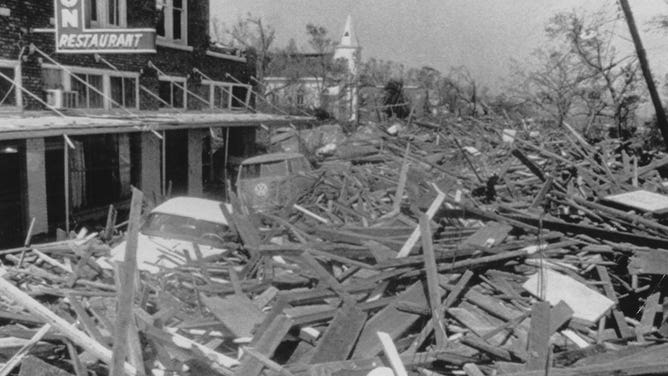
Officials fear when rubble like this shown in downtown Pass Christian is cleared, many more bodies will be found. The rising death toll made Camille the biggest killer in more than a decade.
(Getty Images)
Larson and his family remained in Gulfport until after his grandfather’s funeral.
"There probably well over 100 people that are buried in the cemetery that have a death date of Aug. 17, 1969, and his is the only one that wasn’t the result of Camille," he said.
Even though Larson’s grandfather died of natural causes, he had heart problems in the past. Larson said he feels that fear of the approaching hurricane was too much for his heart to handle.
"We think it was stress because he knew the hurricane was coming," Larson said. "He died in his sleep. But we think he had been listening to his radio and knew what was coming in a matter of hours. And that could have very well led to his dying."
LEARN HOW TO SURVIVE A HURRICANE IF YOU DIDN'T EVACUATE
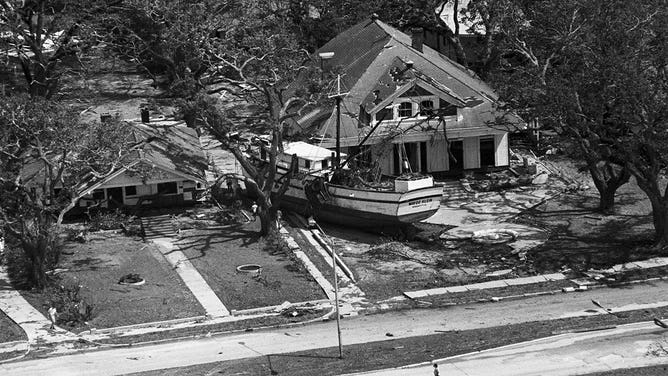
8/18/1969- Biloxi, MS-The Shrimper "Wade Klien" rests against a house that fronts the beach 8/18 where it was deposited by hurricane Camille.
(Getty Images)
Larson and his parents eventually made the journey back home, and they were met by friends and family when they returned.
"My mother had gotten through on the telephone line, and she notified at least one of her friends that we had survived and we were coming home," he said.
Larson said his mother’s friends got together and they, on their own, put together a group of people to greet them when they arrived.
"There must have been like 20 people in the house when we got there," he said. "It was touching, and surprising, because we weren’t expecting it."
